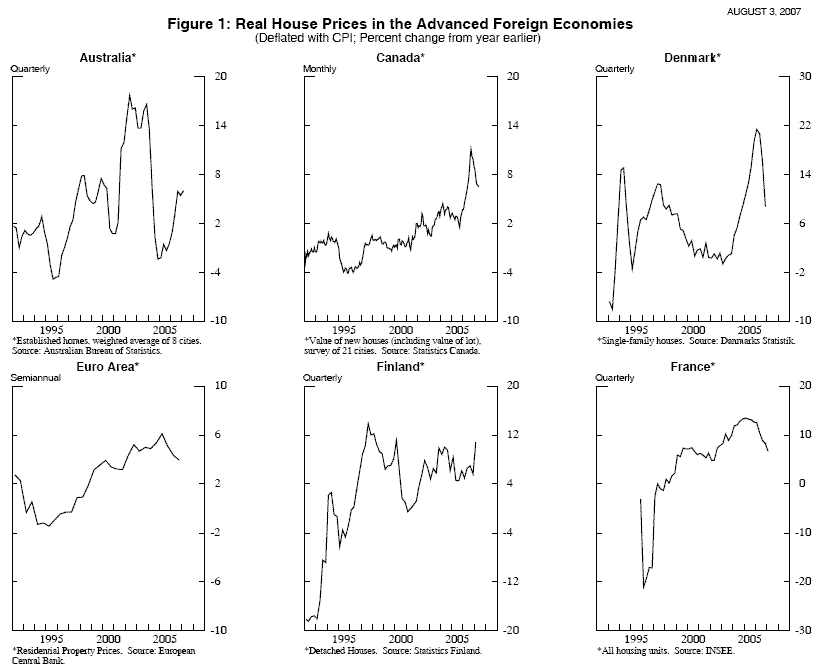In August, Frederic S. Mishkin a member of the Board of Governors of the Federal Reserve Bank authored a paper with the rather technical title of Housing and the Monetary Transmission Mechanism which explored how the Fed should react to a bursting of the housing bubble. One idea explored and advocated was a drop in short term rates.
The 50 basis point reduction in the federal funds rate by the Fed seems to indicate that they are trying to prevent a more severe downturn in the housing market.
Here are some highlights from that report:
The performance of housing in the United States and other developed countries over the last 10 years.

Mortgage delinquincy rates:

"How monetary policy makers might respond to the house-price decline is outlined in figure 6. These simulations show what happens when monetary policy responds optimally, under the assumption that policymakers do not anticipate the house-price decline but set policy optimally when the price decline is realized.23 The solid line shows the optimal response and outcomes for the benchmark version of the FRB/US model, while the dashed line shows the optimal response in the model with magnified transmission mechanisms. The first thing to notice by comparing the top panel in figure 6 with the top panel in figure 5 is that the federal funds rate is lowered more aggressively and substantially faster than with the Taylor-rule reaction function. This difference is exactly what we would expect because the monetary authorities would not wait to react until output had already fallen, as in the Taylor rule, but instead would react immediately to the house-price decline when they see it. As can be seen in the other panels of figure 6, optimal policy can be extremely successful at counteracting the real effects of this very large housing slump. In the benchmark model, the level of real GDP falls only ![]() percent relative to baseline, and the unemployment rate rises only 1/10 percentage point above its baseline level. In the model with magnified transmission mechanisms, the peak decline in real GDP is about
percent relative to baseline, and the unemployment rate rises only 1/10 percentage point above its baseline level. In the model with magnified transmission mechanisms, the peak decline in real GDP is about ![]() percent, with the unemployment rate rising 2/10 percentage point. One of the reasons that monetary policy is so successful at counteracting the effects of the house-price decline is that the long lags from changes in housing wealth to changes in consumer spending allow the monetary authorities plenty of time to respond to the house-price decline.24"
percent, with the unemployment rate rising 2/10 percentage point. One of the reasons that monetary policy is so successful at counteracting the effects of the house-price decline is that the long lags from changes in housing wealth to changes in consumer spending allow the monetary authorities plenty of time to respond to the house-price decline.24"
As this shows, the Fed model indicates that aggressive lowering of the federal funds rate seems to have a positive impact on blunting the negative impact of a falling housing market.
This fact, more than anything else may have been responsible for the Fed's aggressive cut. If housing continues to fall look for the Fed to adjust rates further.
Of course, this brings up the question, when do we eventually take the bitter pill? The Fed can't keep rates low forever. At some points, housing is going to have to readjust.





Add your Comment
use your Google account
or use your BestCashCow account